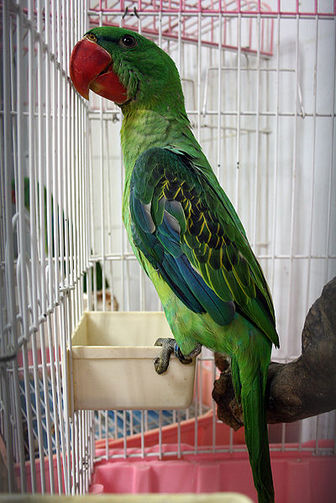Great-billed Parrot
The Great-billed Parrot is found in forest, woodland and mangrove in the south-east Asian islands of Maluku, Raja Ampat, Talaud, Sangir, Sarangani, the Lesser Sundas, and nearby small island. The diet consists mainly of fruits.

Original source: TJ LinPermission(Reusing this file)This image, which was originally posted to Flickr.com, was uploaded to Commons using Flickr upload bot on 02:48, 20 February 2009 (UTC) by Snowmanradio (talk). On that date it was licensed under the license below. This file is licensed under the Creative Commons Attribution-Share Alike 2.0 Generic license.You are free:to share – to copy, distribute and transmit the work
Author: TJ LinPermission(Reusing this file)This image, which was originally posted to Flickr.com, was uploaded to Commons using Flickr upload bot on 02:48, 20 February 2009 (UTC) by Snowmanradio (talk). On that date it was licensed under the license below. This file is licensed under the Creative Commons Attribution-Share Alike 2.0 Generic license.You are free:to share – to copy, distribute and transmit the work
The Great-billed Parrot is classified as Least Concern. Does not qualify for a more at risk category. Widespread and abundant taxa are included in this category.
The Great-billed Parrot is found in forest, woodland and mangrove in the south-east Asian islands of Maluku, Raja Ampat, Talaud, Sangir, Sarangani, the Lesser Sundas, and nearby small island. The diet consists mainly of fruits. It remains widespread and locally fairly common, and consequently has been rated as Least Concern on the IUCN Red List of Threatened Species. References - * BirdLife International (2004). Tanygnathus megalorynchos. 2006. More
The Great-billed Parrot, Tanygnathus megalorhynchos, is a glorious green with yellow and black scalloping on the wing, a bright blue rump, and a spectacular orange/red beak. They have fairly long tails, though not as long in proportion to their bodies as a macaws or conures. The males are a bit larger than the females with a much larger, almost disproportionate beak and a flat head. Currently there are very few Great-bills in the United States. More
Wild Great-billed Parrot perched in tree, Buru Island, Indonesia Credit: © Mehd Halaouate | http://www.indonesien.nu/indonesieneng/index.shtml photos Photos videoVideo 1 Video 2 eNewsletter SIGNUP FOR EMAIL UPDATES Did You Know?The Great-billed Parrot prefers small islands and will travel widely between them. More
Great-billed Parrot Tanygnathus megalorynchos sumbensis Great-billed Parrot Photographer : More
Great-Billed Parrots (and other Tanygnathus species) in the Wild: Increasing Cause for Concern = by Stewart Metz, M.D. When the Indonesian undercover investigative team KSBK (now called ProFauna Indonesia) looked at major bird-selling markets in Jakarta, Indonesia, they found that Great-billed Parrot was the least common parrots seen. Concomitantly it was the most expensive , even more so than cockatoos (Ref. #1). More
Great-billed Parrot, Tanygnathus megalorhynchos affinis - Great-billed Parrot, Indonesia, Sidangoli, Halmahera September 2005 © Pete Morris/Birdquest Aptly named!! Birdquest website Send this as a postcard Great-billed Parrot - Great-billed Parrot, Halmahera, Foli sept 2006 © Paul Noakes Great-billed Parrot - Showing Records 1 through 3 of 3 Total Records More
Family : Psittacidae
Genus : Tanygnathus
Species : megalorynchos
Authority : (Boddaert, 1783)

